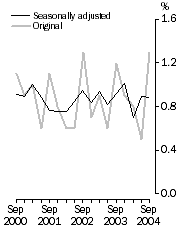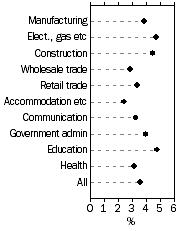SEPTEMBER KEY FIGURES
Quarterly changes, Total hourly rates of pay excluding bonuses

| Annual change: original, Total hourly rates of pay excluding bonuses - For selected industries

|
SEPTEMBER KEY POINTS
TOTAL HOURLY RATES OF PAY EXCLUDING BONUSES
QUARTERLY CHANGES (JUN QTR 2004 TO SEP QTR 2004)
- The index for all employee jobs in Australia increased by 0.9%, seasonally adjusted.
ANNUAL CHANGES (SEP QTR 2003 TO SEP QTR 2004)
- The seasonally adjusted increase through the year to September 2004 for all employee jobs in Australia was 3.5% (in trend terms, 3.4%).
LABOUR PRICE INDEX EXCLUDING BONUSES
CHANGE 2003-04 FROM PREVIOUS FINANCIAL YEAR
- The change from the previous financial year for 2003-04 was 3.5%. This is slightly lower than the change in the same period in the total hourly rates of pay excluding bonuses index of 3.6%.
NOTES
ABS DATA AVAILABLE ON REQUEST
Original indexes are compiled for various combinations of state/territory, sector (private/public), broad industry group and broad occupation group. Seasonally adjusted and trend indexes are only compiled for total hourly rates of pay excluding bonuses for the private sector, public sector and all sectors. Indexes not included in this publication may be made available on request by telephoning Perth (08) 9360 5151.
CHANGES IN THIS ISSUE
The title of this publication has changed from Wage Cost Index, Australia to Labour Price Index, Australia. The new name identifies the publication as one of the price indexes produced by the ABS and also reflects the inclusion of non-wage and labour price indexes. The content and ordering of all tables previously published in this publication have not changed. Eleven new tables are included in this issue presenting non-wage and labour price indexes.
New price indexes covering selected non-wage costs have been included in respect of annual and public holiday leave, superannuation, payroll tax, and workers' compensation. In addition, two labour price indexes have been constructed (one including bonuses and one excluding bonuses) from the wage and non-wage components. The non-wage and labour price indexes are available for financial years from 2001-02 onwards. The new indexes will be published in November each year as part of the September quarter Labour Price Index, Australia (cat. no. 6345.0).
All index numbers have been released on a new reference base of 2003-04; i.e. the numbers in each index series have been reset to equal 100.0 for the financial year 2003-04. Details about the re-referencing process and how to convert the rebased quarterly series of index numbers back to the previous reference base of September quarter 1997 = 100.0 are provided in Appendix 2.
FURTHER INFORMATION
More detailed information on the Labour Price Index is available in Information Paper: Labour Price Index, Australia 2004 (cat. no. 6363.0) and Labour Price Index, Concepts, Sources and Methods, Australia (cat. no. 6351.0.55.001).
INQUIRIES
For further information about these and related statistics, contact the National Information and Referral Service on 1300 135 070 or Tim Landrigan on Perth (08) 9360 5151.
COMMENTARY
WAGE PRICE INDEXES
Safety Net Review (SNR)
The Australian Industrial Relations Commission handed down its lastest SNR decision on 5 May 2004, which increased federal full-time minimum award rates by $19 per week. The $19 increase equates to a 4.24% wage increase for those jobs paid minimum award rates (i.e. an increase to $467.40 per 38 hour week). All equivalent state and territory jurisdictions passed on the same increase to those awards within their jurisdiction. The date of effect in Queensland was 1 September 2004 which was after the reference period for the September quarter wage price index (the pay period ending on or before 20 August 2004) but in all other states and territories the date of effect was prior to this reference date. As a consequence, the SNR decision has resulted in increases in September quarter 2004 for some employees paid under relevant awards in those states and territories. It is not possible to determine the relative contribution of the SNR to the increase in the wage price index in the September quarter.
Pay mechanisms
The pay mechanisms behind the increases in the private sector were primarily salary reviews and collective agreements. In the public sector, collective agreements accounted for most of the increase.
NON-WAGE PRICE INDEXES
Annual and public holiday leave
The percentage change from the previous financial year for All Sectors, Australia for 2003-04 was 2.6%. All states contributed to this increase except for Victoria with -0.5% and Tasmania 0.0%. In the majority of states and territories there were minimal changes in annual leave and public holiday entitlements and the index was driven by increases in wages growth.
In 2002-03 ANZAC Day fell on Friday, whereas in 2003-04 it fell on a Sunday. Unlike other states and territories, Victoria and Tasmania did not provide an additional day off in lieu in 2003-04. As a result, the price of public holidays in these two states decreased in 2003-04.
Superannuation
The percentage change from the previous financial year was 11.8% for 2002-03 and 3.7% for 2003-04. The reason for the high rate of change for 2002-03 was the increase in the Superannuation Guarantee Levy which rose from 8% to 9% in July 2002. This increase was reported by employers for more than two-thirds of jobs in the sample.
 Print Page
Print Page
 Print All
Print All